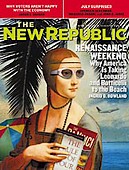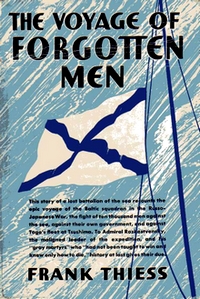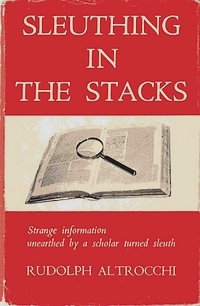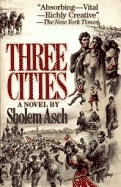· Excerpt
· Editor’s Comments
· Other Comments
· Find Out More
· Locate a Copy
Excerpt
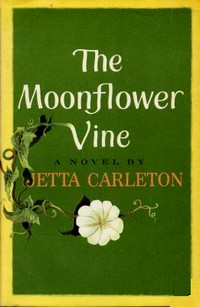
To his daughters as they grew up, Matthew Soames was God and the weather. He was omnipotent and he was everywhere — at home, at school, at church. There was no place they could go where the dominating spirit was not that of their father. And, like rain or shine, his moods conditioned all they did.
With other people around, he was pleasant as could be, full of laughter and witticisms and conversation marvelous to hear. Ladies often said to them, “Your father is just the nicest man!” The girls could hardly help observing that he turned his sunny side to his public and clouded up at home. There, he was often preoccupied and short-spoken, indifferent to his children except to command or reprove. “Daughter,” he called each of them indiscriminantly; it was a little more authoritative than the given name, which might not occur to him at the moment anyway.
“Papa’s nicer to other people than he is to us,” Leonie once said.
“Yes, sometimes he is, honey,” said her mother. “But he’s got to be. Your Papa’s an important man in the community. That’s the way he’s got to act.”
His importance might have been a comfort to the girls if it hadn’t been such a nuisance. There were so many things they were not allowed to do “because it wouldn’t look well.” And they couldn’t get out of his sight and do them, because he was everywhere. For the most part, they resigned themselves to the situation and did as Papa said. The purpose in life, he said, was to work. “Laborare est orare,” he said; and work meant to study your lessons and help Mama.
They had many good times in between. Relatives came often to visit. On the farm they could play in the woods and go fishing. When they moved to town they had girl chums and Sunday School parties. They had no toys to speak of (one doll, handed down from one to the other); but living as they did a good deal out-of-doors, they didn’t need such props. They played with what they had or found or made up and enjoyed themselves hugely. But very early they understood that playing was somewhat suspect, allowed only through indulgence, a trivial pastime soon outgrown, and only about twice removed from sin. Pleasure was only once removed. The girls grew up before they realized that pleasure was not an ugly word. In their father’s vocabulary it meant joyrides, dancing, card games, cigarettes, and other things to dreadful to define.
Editor’s Comments
I read The Moonflower Vine after coming across Jane Smiley’s discussion of it in her Thirteen Ways of Looking at the Novel. It wasn’t so much what Smiley had to say about it as that it was essentially the only genuinely little-known novel she saw fit to include in her list of 100 great novels. In there amongst Wuthering Heights, Moby Dick, and Ulysses was this book with a completely unfamiliar title and by completely unfamiliar author. To see a neglected book rate such high-profile coverage alone made it worth a try.
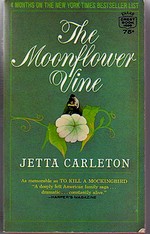 I can’t say that The Moonflower Vine would have stood much chance of a second look from me had it not come with such a sterling recommendation. Its marketing, back when it was picked as a Literary Guild selection and condensed in a Readers Digest collection, was definitely aimed at a feminine audience, and its first paperback edition featured a small picture of a big, strong, dark-haired man embracing a delicate young woman — the sort of image that’s become the cliche of gauzy romantic novels.
I can’t say that The Moonflower Vine would have stood much chance of a second look from me had it not come with such a sterling recommendation. Its marketing, back when it was picked as a Literary Guild selection and condensed in a Readers Digest collection, was definitely aimed at a feminine audience, and its first paperback edition featured a small picture of a big, strong, dark-haired man embracing a delicate young woman — the sort of image that’s become the cliche of gauzy romantic novels.
As Bo Diddley sang, though, you can’t judge a book by looking at the cover. There’s barely a lick of romance in the whole of The Moonflower Vine. Carleton grew up on a Missouri farm perhaps not too unlike that described in her novel, and no farm family that survives a hard winter or a bad harvest has much romanticism left in its veins. The pragmatism of farm life is multiplied by the stern morality of the Midwest Methodist, with its clear-cut sense of right and wrong (and none of the Southern Baptist’s taste for a little melodramatic back-sliding).
The Moonflower Vine is a multi-dimensional tale of the lives of Matthew Soames, his wife, Callie, and their four daughters — Jessica, Leonie, Mathy, and Mary Jo. Mary Jo is probably closest in profile to Carleton herself. The youngest of the girls, she is roughly the same age as Carleton and, like her, left rural Missouri for a career in the world of television in New York. She narrates the introductory section of the book, which takes place one summer Sunday when the daughters (with the exception of Mathy, who dies before the age of twenty) have come back to the family farm for a visit. This section is gentle, lightly comic, and bucolic in its description of rustic pleasures such as skinny-dipping in the creek.
The rest of the book, however, is related in the third person. Starting with Jessica, it deals in turn with each of the other members of the family — Matthew, who struggles throughout his career as a teacher and principal of a small town school with a lust for bright young women in his classes; Mathy, the family rebel, who elopes with a barnstorming pilot; Leonie, the dutiful daughter, who never quite manages to find her right place in the world; and finally, Callie, the mother, whose brief moment of adultery mirrors her husband’s own private sin.
Sin is a constant presence in the book. Everyone in the family, with the possible exception of Mary Jo, commits one or more sins, in their own eyes or those of the community, that prevents any form of love expressed in the book from being completely unequivocal. Matthew never fully forgives Mathy for quitting school and running off with one of the local renegades, nor Jessica for marrying a drifter Matthew takes on briefly as a hired hand. The Soames are a God-fearing family, stalwart members of the Methodist Church, very much Old Testament Christians.
At the same time, though, progress makes its own changes in their lives. While Matthew and Callie refuse to install indoor plumbing, planes, trains, and automobiles all bring the outside world a little closer to their doorstep. Jessica and her new groom catch a train for his family home in southern Missouri — genuine hillbilly country — and though he dies less than a year later, she remains with his people thereafter. Ed, one of Matthew’s old students, returns to town with an old biplane and proceeds to sweep daughter Mathy off her feet, only to kill her a year or two afterwards in a crash landing. Some time later, Leonie takes a trip to Kansas City, meets a somewhat reformed Ed, and eventually decides to marry him.
Though The Moonflower Vine is full of lush descriptions of the trees, birds, flowers, and plants that fill the Soames’ world, it’s very much a Midwestern, rather than Southern, novel. The comedy and tragedy are always moderated with a spare sense of realism. Missouri is, after all, the “Show Me” state — that skepticism prevents any of the characters from leaping headlong into any of their passions for more than a moment or two. Or, rather, it makes them look before leaping, if leap they do.
As the reviews of The Moonflower Vine on Amazon.com demonstrate, this novel, though long out of print, continues to hold a fond place in the hearts of readers who’ve discovered it. Carleton never wrote another book, though she did publish over 100 others through the Lightning Tree, a small press she founded with her husband, Jene Lyon, after she left the television business and moved to New Mexico. She died there in 1999.
Other Comments
- · Jane Smiley included The Moonflower Vine among the classics she read (or reread) and then discussed in her 2005 book, Thirteen Ways of Looking at the Novel, and wrote of it:
- This novel may be the most obscure contemporary novel on our list, but those who have read it, if the customer reviews at Earth’s Biggest Bookstore™ are any guide, are very loyal to it. Jetta Carleton wrote only this novel, which appears to be autobiographical, at least in part, but Carleton’s style is so dense and precise and her method of imagining the inner lives of each character so daring that she seems to have been unconstrained by fears either of remembering things wrongly or of offending her relatives….
Carleton mostly avoids the perils of this material, which, baldly summarized, sounds scandalous and best-sellerish, a Peyton Place of the Midwest, by depicting the southern Missouri landscape of the family farm in exceptional detail. The farm is small but much beloved, full of fields and grasses, trees and shrubs, rocks and flowers that present a seasonal drama to the members of the family. All admire and appreciate their natural surroundings, sometimes in spite of themselves. Since most of the novel takes place in the summer, when the family is settled on the farm, the characters frequently suffer from the heat, which has the effect of making the scenery palpable and especially sensual.
The five characters are a convincing family in several ways. They resemble one another but are ill-assorted, as members of families often are. Their contrasts to one another are exaggerated by proximity. Matthew loves Callie and she is essential to his sense of his identity and self-confidence, but her lack of interest in intellectual things (she can’t read, though she pretends sometimes she can) means that he can’t share things with her that are important and satisfying to him. Callie is sexy but submissive, and hardly ever dares to challenge Matthew, or even ask anything of him. She recognizes, though, that he had been the best bet of all the young men she might have chosen, and in the end he is a good husband even though he hasn’t shown her the tenderness she might have liked. Carleton excels at depicting the personalities of the girls, who often don’t understand one another at all, and would never, they think, make the choices that the others have made, or even have similar relationships to their parents. And yet there is familial loyalty and attachment, mostly arising out of a shared sense of the enjoyment of the farm and each other.
To my mind, this is a novel characteristic of its time, the 1950s, because it completely avoids all political themes. To read it you would never know that black people existed in southern Missouri, that the area was still a hotbed of post–Civil War resentments, that the Cold War was raging, and that World War II had taken place. The novel exists in a timeless world of seasons and of girls coming of age, love their greatest concern, with earning a living teaching school or giving music lessons a distant second. The Soames family thinks only of religion, love, nature, and sometimes music. They are American innocents in spite of their lustiness, quite untainted by the compromises of American history. The novel is neither liberal nor conservative — more, perhaps, tribal, in the sense that while the characters do make authentic connections, these connections are only within their own family rather than with anyone outside (except for Jessica, who moves away). In addition, the world is repeatedly redeemed, not by human action but by natural renewal, as symbolized by the nightly flowering of the moonflower vine (a relative of the morning glory). In the end, none of the characters comes to an understanding of Christianity or Christian precepts — doctrines of fundamentalist Protestant religion don’t seem to fit what they have learned — nor do they embrace their sexuality (though they seem to learn that they can’t get rid of it), but they do come to an understanding of the nature and purpose of forgiveness, and each character achieves a feeling that happiness, even fleeting happiness, is to be recognized and cherished. Several American novels on our list — The House of the Seven Gables, The Awakening, To Kill a Mockingbird, and The Moonflower Vine — gain considerable dramatic tension from secrets that the characters are required to keep to maintain respectability in the towns where they live. The conflict between who a character feels herself or himself to be and what is acceptable to friends and colleagues is as constant a theme in American novels as, say, a character’s relationship to the state is in German novels. In exploring the romantic secrets of each member of a single family, Carleton offers something of a catalog of ideas on the subject of secret desires — The Moonflower Vine could have been a scandalous novel. But by presenting each character’s desire as a moral dilemma for that character, and especially by consistently depicting the bonds of love that eventually hold the family together, she succeeds in arousing both empathy and sympathy in the reader. At the same time that she portrays the abnormality of her family, she demonstrates that abnormality is always more complex than it appears on the surface.
- · H. C. Gardiner, America, 2 February 1963
- The amazing thing about the people who come so alive in this novel — it is called a novel, but despite the author’s statement that it is mostly fiction one cannot escape the feeling that it is all recaptured by a loving memory — is the fact that they had so much fun, uder circumstances that seemed to promise anything but fun…. Perhaps the second most remarkable aspect of the book is that this sense of serenity is achieved without sliding into Pollyanish sentiment.
- · M. Moriarty, Best Sellers, 1 February 1963
- Whether or not it will be a critical success, The Moonflower Vine is a well done picture of a more innocent, simpler era, when sin was sin and duty was duty and God in His heaven was acknowledged and worshipped.
- · Barbara Fielding, ReviewersChoice.com, 2003
- Jetta Carleton’s autobiographical novel captures the mood and times of midwestern rural life and brings it to life. From the idyllic, heartwarming beginnings springs dark and hidden truths; truths only the reader will see and know. The gentle revelations of the secrets, fears and heartaches that drive these wonderful and endearing characters is storytelling at its best.
Find Out More
- · Rosina Lippi, who writes under the nom de plume Sara Donati, on reading The Moonflower Vine:
- I first read this book in German when I was living in Austria. I loved it so much I tracked down the original English, and ever since I’ve been re-reading it on a regular basis. Whenever I see a copy in a used bookstore I buy it to give away. This is the story of a farm family in Missouri, set in the early part of the last century. Each section is told from the perspective of a different family member. This is a beautifully written, carefully constructed story that I have never tired of over the years.
- · A page on the Lightning Tree Press, the small press Jetta Carleton set up with her husband in New Mexico in 1973
Locate a Copy
- Look for it at Amazon.com: Find it!
- Look for it at Amazon.co.uk: Find it!
- Look for it at AddAll.com: Find it!

 A very short novel that got lost in the shuffle when first published because it had the misfortune to appear at roughly the same time as Eco’s The Name of the Rose, a much longer, louder, and easier to read book with which it has some superficial things in common (monks, murder, Middle Ages). Fuller is the British poet, not to be confused with the American writer of the same name. The book begins with an amazingly vivid description of an unsuccessful attempt to land a horse on a rocky island from a small boat, and the writing remains at the same level throughout, even as the story gets stranger and stranger.
A very short novel that got lost in the shuffle when first published because it had the misfortune to appear at roughly the same time as Eco’s The Name of the Rose, a much longer, louder, and easier to read book with which it has some superficial things in common (monks, murder, Middle Ages). Fuller is the British poet, not to be confused with the American writer of the same name. The book begins with an amazingly vivid description of an unsuccessful attempt to land a horse on a rocky island from a small boat, and the writing remains at the same level throughout, even as the story gets stranger and stranger.
 That winter, the old General moved from the rooms he had rented from the free mulatto, Wormley, in I Street to Cruchet’s at Sixth and D Streets. His new quarters, situated on the ground floor–a spacious bedroom, with a private dining-room adjoining–were convenient for a man who walked slowly and with pain; and Cruchet, a French caterer, was one of the best cooks in Washington.
That winter, the old General moved from the rooms he had rented from the free mulatto, Wormley, in I Street to Cruchet’s at Sixth and D Streets. His new quarters, situated on the ground floor–a spacious bedroom, with a private dining-room adjoining–were convenient for a man who walked slowly and with pain; and Cruchet, a French caterer, was one of the best cooks in Washington.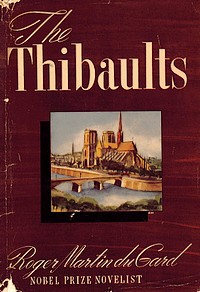 Reader Chris Leggette recommends Roger Martin du Gard’s family saga,
Reader Chris Leggette recommends Roger Martin du Gard’s family saga, 

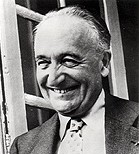 For my own part, I have to admit that I’ve cracked
For my own part, I have to admit that I’ve cracked 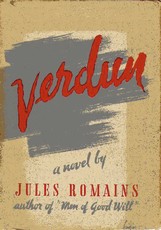 It is true that I haven’t read every one of its 4,256 pages, having sometimes been overcome with yawns in the middle of Jerphanion’s arch and soulful letters to his fellow student Jallez. On the other hand, I have read every word of Vols. I, II, III, IV (in French and English), VIII, and the greater part of Vols. V, VI, and VII. The eight volumes stand before me as I write — 612 cubic inches of reading matter, fully indexed, with more than half again as much to follow. Yet I can’t convince myself that this is a work that belongs somewhere between the “Comedie Humaine” and “Remembrance of Things Past.” I can’t convince myself that it ranks much above ordinary novels in any quality except sheer size.
It is true that I haven’t read every one of its 4,256 pages, having sometimes been overcome with yawns in the middle of Jerphanion’s arch and soulful letters to his fellow student Jallez. On the other hand, I have read every word of Vols. I, II, III, IV (in French and English), VIII, and the greater part of Vols. V, VI, and VII. The eight volumes stand before me as I write — 612 cubic inches of reading matter, fully indexed, with more than half again as much to follow. Yet I can’t convince myself that this is a work that belongs somewhere between the “Comedie Humaine” and “Remembrance of Things Past.” I can’t convince myself that it ranks much above ordinary novels in any quality except sheer size.
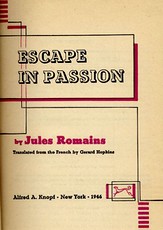 Once I returned to Varsity after Christmas I lost no time in starting upon volume one. In this book alone I met about sixty characters, most of whom appeared throughout the series. On and on I went. I paused for the Easter exams; and then while I sought volume four, missing at
Once I returned to Varsity after Christmas I lost no time in starting upon volume one. In this book alone I met about sixty characters, most of whom appeared throughout the series. On and on I went. I paused for the Easter exams; and then while I sought volume four, missing at 